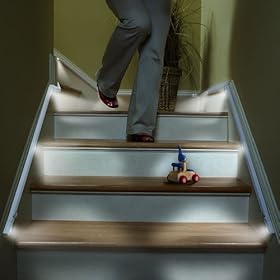
As I have previously expressed, I have wished for motion sensor lights that fade in and fade out (so they aren't as jarring). I think this way people would be more willing to embrace motion sensors, and thus not leave lights on in a room that the might come back to shortly.
Make magazine has a question from "Shawin" on their website on how to make one of these yourself. He asks:
"We are renovating an old house we just bought and I wanted to have the rooms fitted with motion-sensors so that lights automatically turn on when someone walks in, and off when the room is empty. The problem is that I want the lights to fade-in/out instead of suddenly turning on/off.
Can someone please tell me how to do that? Are there existing switches that I could use?"
There are some suggested approaches on how to do this but no existing products mentioned.
For those of the less diy electronics set I found some ledon the web:
Philips Stumblelight:
"Upon detecting motion at night, StumbleLight instantly provides light at full intensity for 12 seconds and, if no motion is detected after 12 seconds, will slowly fade from full intensity to off."
Philips press release
Ecopaball:
"Light fades out gently when no motion is detected
No wiring required (requires 4C sized batteries)
Minimal battery consumption provides up to 6 months use
Only works at night due to a built in a photo sensor"
Most of the motion sensor lights I found have a limited motion sensor range. Some add infrared detection to the motion to reduce false activations. Many turn off after thirty seconds (not really long enough in my book as there are too many things for people to stand behind in a house for 30 seconds)
Some have a photo cell so they don't waste energy turning on when it's light out.
This one glows dimly then turns on full bright when it senses motion
So does the 2nd one and it also has a photo cell
Stairs product from smart home depected at top
Many of the ones I have bought suffer from being too dim and a lot of the reviews agree.
One note for those making their own with motion sensor switches, using LEDs will give you a much nicer experience than fluorescents because they don't have the pause and flicker on turn on. LEDs are being used for brake lights because they turn on so fast (of course I'm asking for gradual turn on which doesn't require fast, but if there is a pause before it starts to do anything people think the motion sensor isn't working and get annoyed)
On amazon I found a motion sensor LED light that advertised:
"the sudden activation startles unwanted visitors but also provides safe entrance and room lighting for your family and guests."
Am I barking up the wrong tree here?


 Home automation is expensive and complicated, but universal remotes are easy. The IR-Remote Control
Home automation is expensive and complicated, but universal remotes are easy. The IR-Remote Control 

 Although having two built-in
Although having two built-in 



